At the Milan Design Week 2022, Saint-Louis presents Cadence a new contemporary collection, in collaboration with French designer Pierre Charpin.

From tableware to lighting, through barware and decoration, the objects of the new contemporary collection Cadence created by Saint-Louis in collaboration with French designer Pierre Charpin, are designed for everyday use. Based on the interplay of horizontal and vertical lines, Pierre Charpin’s drawings give rhythm to material, enhancing its brilliance and clarity. A definitely modern vision of crystal: a collection of accessible objects that rings true, in tune with today.
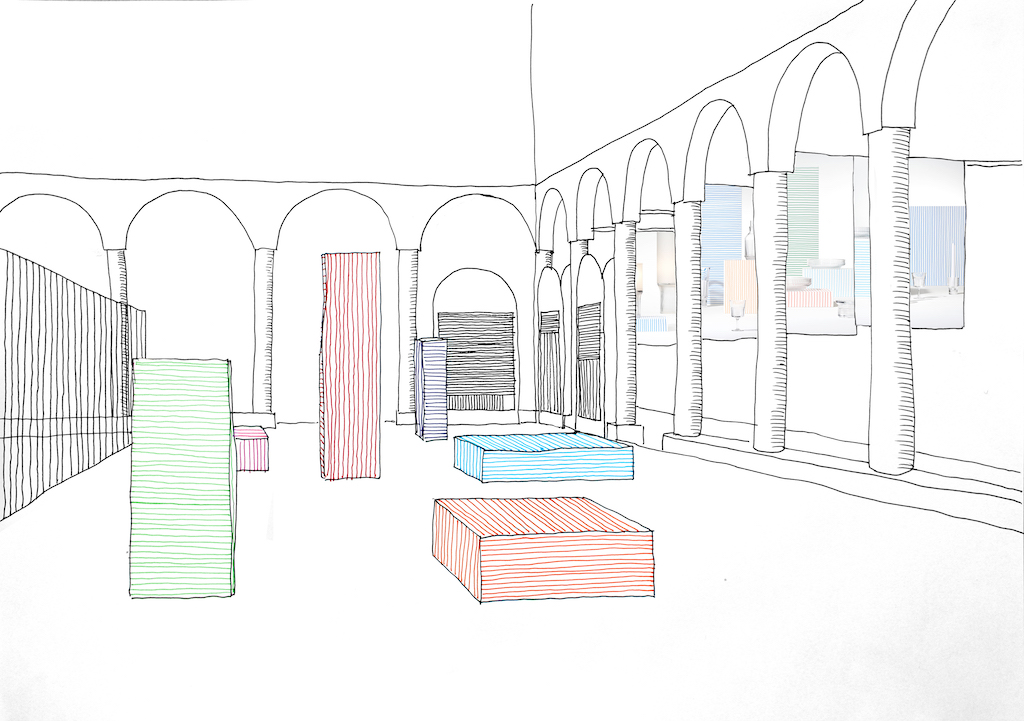
Saint-Louis showcases Cadence in an immersive installation designed by Pierre Charpin in the Chiostro di Santa Maria del Carmine, during the Milan Design Week 2022. A contemporary art exhibition, where surprising volumes met hand-drawn coloured lines and plays of light and crystal, in the heart of the Brera district.
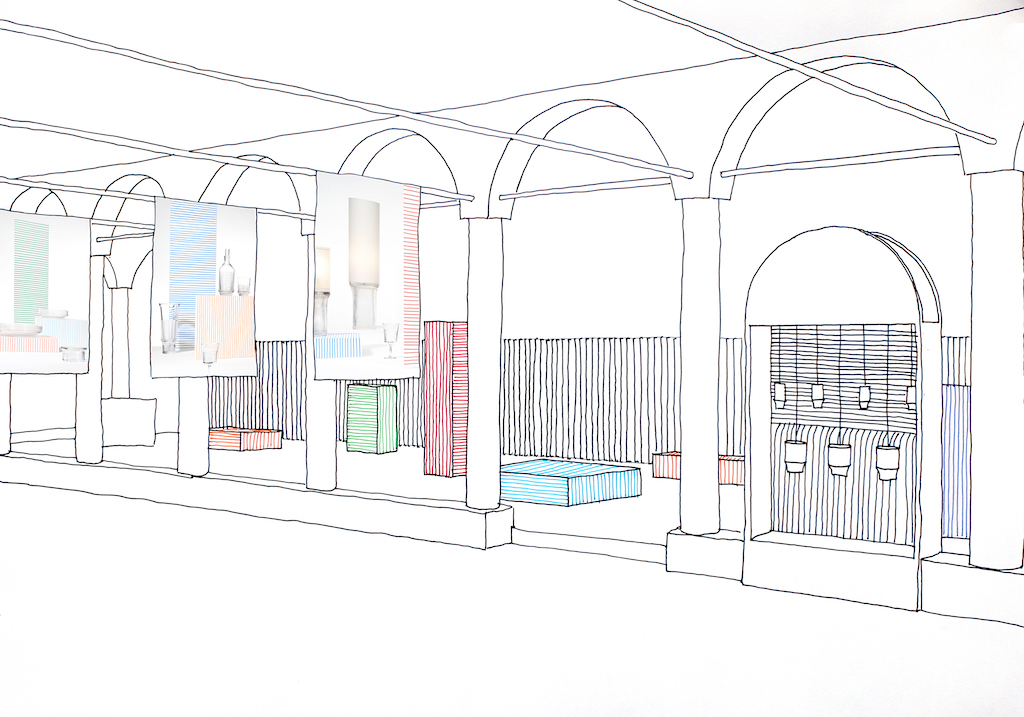
Cadence pays tribute to the virtuosity of Saint-Louis artisans and highlights iconic traditional skills.

Cadence paper lampshades, on the other hand, were tailor-made for the collection by two design houses awarded the label “Living heritage companies” given to great French workshops with exceptional skills. The paper is made by a studio in Eastern France established over four hundred years ago in Strasbourg. Its specific composition allows the horizontal lines to appear translucent when the light is on. These marked lines are hand hot-stamped. The shade is then hand-fabricated with this unique paper by a second craft workshop.
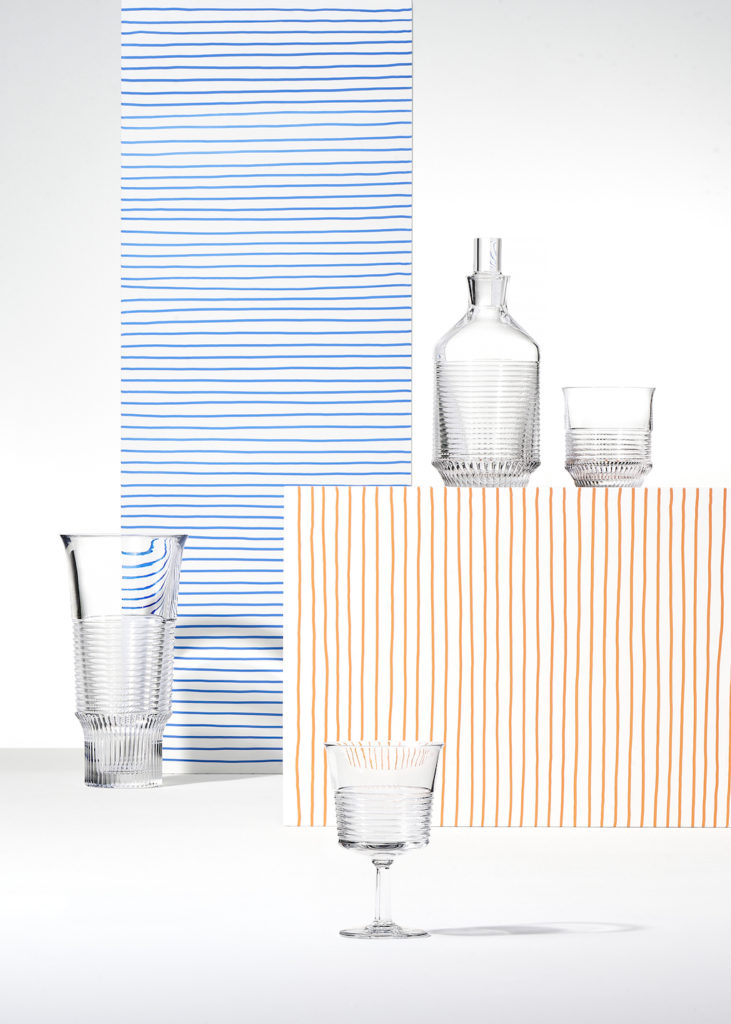
Based on the interplay of horizontal and vertical lines, Pierre Charpin has created a unifying language. The lines suggest the function and use of each design: horizontal lines contain liquids; vertical lines suggest elevation – e.g., stemmed glasses and lighting stands.
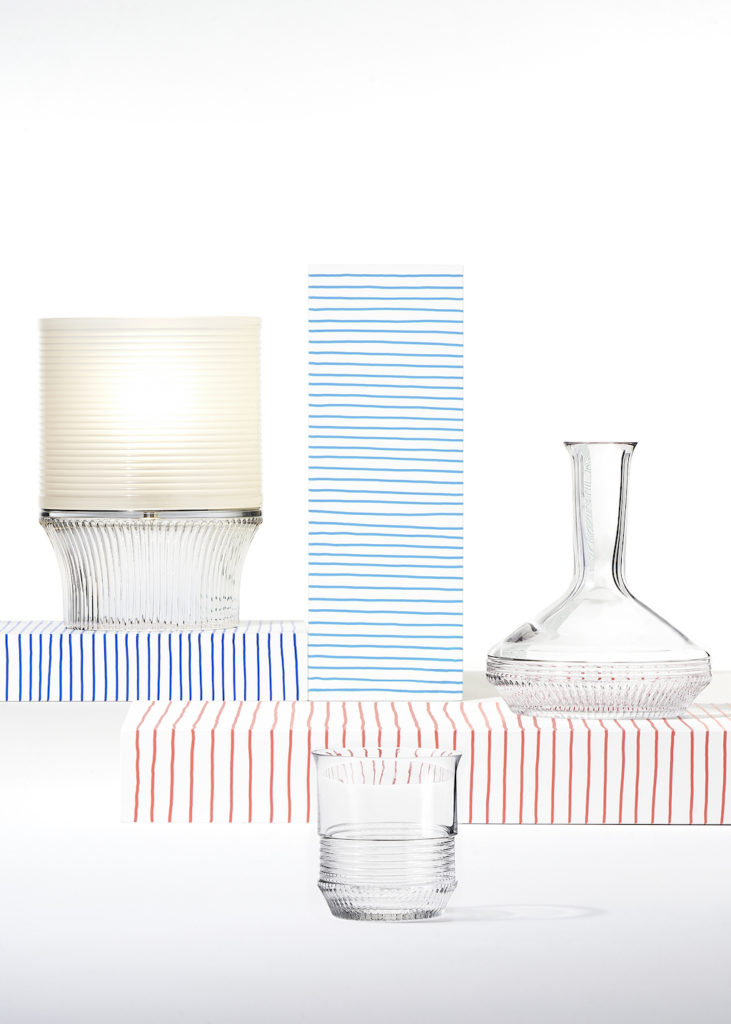
The lines punctuate the objects’ material in a regular and systematic way from one product to another. For this vocabulary of simple forms, Pierre Charpin invoked multiple influences, from the Viennese Secession to the Memphis movement. Each of these artistic trends liberates itself from the bourgeois and ostentatious heaviness of the past to focus on the essentials.
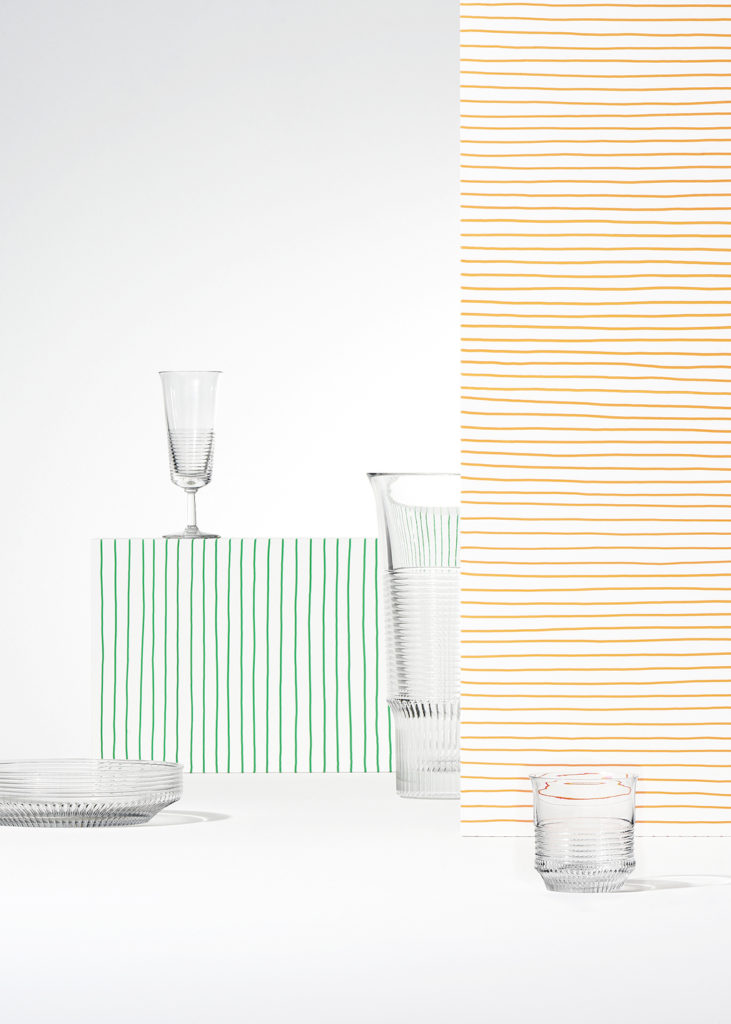
The precision of the line gives life to objects that are accessible and fitting to their context. They are present, useful, and discreet. These pure forms have been designed for everyday use despite being made from a more formal material like crystal. The short leg of the stemmed glasses is the best example of this principle. By advocating a radically modern and simple version of crystal, Saint-Louis invites everyone to use crystal every day, without mannerisms.

The designer’s point of view
“A journey to the Saint-Louis crystal manufactory starts with an early morning high-speed train ride to what has now become known as the Grand-Est region. After the train, comes an hour-long car ride through the rolling, pastoral countryside, to finally drop down into the village of Saint-Louis-lès-Bitche, in the heart of a densely wooded area close to the German border. The view from above as you approach clearly shows that the manufactory is both the origin and beating heart of the village. Entering the manufactory is to enter into a strikingly binary world made up of two opposing yet inseparable entities. This duality seems to define not only the crystal material but the very essence of its creation and production. The workshops are made of two adjoining poles: hot and cold. Each pole creates its own universe, complete with its own temperature, sounds, smells, light, rhythms, spaces, colours, tools, lexicon, gestures, and clothing. When hot, the crystal is formless, awaiting transformation. Starting as an incandescent viscous paste in the oven, it is given form by being hand-blown or shaped using a mould, until it solidifies into a glass, a tumbler, cup, carafe, bottle, or vase… When cold, all is reversed. The crystal piece is already well-defined. Its shape is reworked and cut using grindstones of different shapes and diameters, and it is the final polishing stage which creates its lustre and limpid, cold transparency. Only then is the form imbued with all of the signature qualities of Saint- Louis crystal. It came as a pleasant surprise that eight years after Intervalle – my first foray into the world of Saint- Louis crystal – I was offered the opportunity to design a broad range of pieces ranging from stemware to light fixtures. It was to be a broad-ranging collection, according to the descriptions given during our first exchanges outlining the project. An ambitious collection, both in the number of pieces to be designed and in the aesthetic space it had to fill within the Saint-Louis catalogue. Before going into the details of designing each piece, we had to establish the very notion of what the collection theme would be. After the inevitable trial and error period that comes with the start of any new project, we decided it would be the encounter of vertical and horizontal lines that would be the unifying element through each piece of the collection, later to be named Cadence. A simple idea, which was confirmed through sketches to be a principle malleable enough to adapt to different shapes and sizes, to be an integral part of – and to highlight – the geometry specific to each piece in the collection. Vertical lines adorn the lower parts of each piece – like legs and bases – to elevate the forms. Horizontal lines are cut into the upper part or container of each piece. The meeting point between the vertical and horizontal lines marks the joining between the base and the upper part and, in the abstract, the figurative juxtaposition of the two opposing workshops: the hot and cold. It was clear from the start that each of these pieces had to be designed with simplicity in mind in order to create readable shapes. To design the most archetypal forms possible for each vase, bottle, carafe, cup, tumbler, glass… This desire for simple and readable shapes was an inevitable response to the initial intention to offer pieces that are more accessible, easier to use and void of pretension. An update of the usual crystal pieces – bringing them from the revered to the everyday. For this same reason, glass stems were shortened, making them less slender and solemn, but indisputably easier to use. Likewise, the cutting was simplified to a minimal expression of lines, making it more of an integral part of the form than ornament or decoration, even if still part of the decorative process. During my first visit to the manufactory to truly mark the beginning of this new project, I could not imagine missing out on a trip to the attic, an essential ritual for anyone starting a collaboration with the cristallerie. The attic of a wing far away from the production workshops, this space hasn’t been decorated or turned into a museum. It is inaccessible to the public, slightly dusty and poorly lit, furnished only with large tables that seem to disappear beneath the cacophony of crystal pieces they bear. This is an abundant, wild and varied archive, a journey through time and an understanding of the history of the cristallerie all the way back to its royal origins. What is most striking and somewhat overwhelming when wandering through this assortment, is the immense variety of shapes (some borrowed), techniques (both current and forgotten), colours, and embellishments, to the point that it is difficult to get a precise idea of the manufactory’s specialisation, though cutting is a technique which runs through it all. Eventually, what emerges is that over time the cristallerie’s production has become gradually more specific and specialised, both in technique and also standardised shape-to-size ratios, both of which give Saint-Louis its current image. Or, at least, the image I had of Saint-Louis crystal before I started designing with them. Without a doubt, my goal with this collection was to affirm what Saint-Louis’ crystal is known for, while also making it more accessible to the present, rather than changing it altogether. Thinking about it, at no point in the design process did I imagine these pieces in colour, probably because I didn’t see any point to it, since the quality of the clear crystal is more than enough on its own. But also, perhaps subconsciously, to affirm that this time I am not at Murano. Indeed, I am at Saint- Louis. And that is precisely and above all, what I was seeking to express.”
Pierre Charpin, June 2022
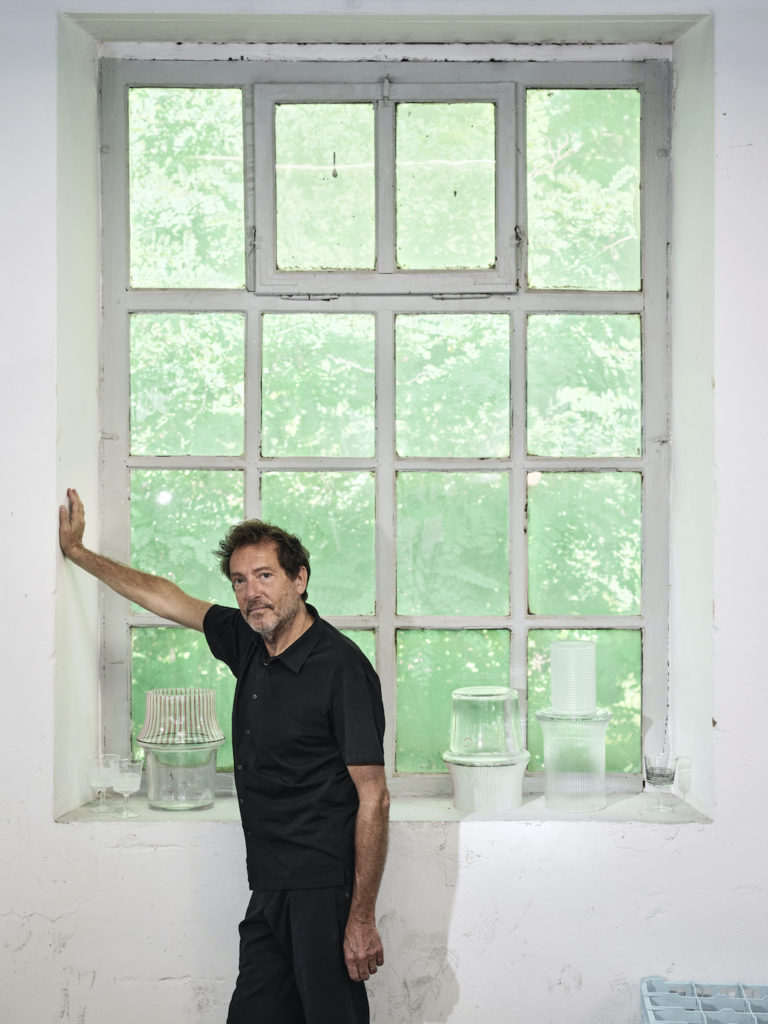
About Saint-Louis
Unrivalled, dense, clear, sonorous, and luminous, born of a ball of fire and the breath of man, Saint- Louis crystal vibrates with the immense talent inherited from history and the extraordinary creative fantasy inspired by current trends. In 1767, Louis XV allowed the construction of glassware manufacture on the location of the previous Münzthal glassware of the 16th century. The majesty conferred the title of Royal Glassware of Saint-Louis to it. Fifteen years later, with the development of the manufacturing formula of crystal, the manufacturer became the Royal Cristallerie of Saint-Louis. Since then, Saint-Louis signs everyday crystal creations – lightings, tableware, decoration pieces and furniture – crafted by master glassblowers and cutters considered to be among the very best in France (“Meilleurs Ouvriers de France”). All possess irreplaceable knowledge and ancestral skills that have been enriched from generation to generation: crystal is mouthblown, hand-cut, hand-engraved and hand-decorated using 24-carat gold or platinum. Using these skills, they made Saint-Louis the master of colours and cuts. With a range of above 10 shades, either mass-coloured or cased and a multiplicity of cuttings from the emblematic diamond one, to the bevels through the pearl, olive, star and cord cuts, the brand offers a large variety of styles and exceptional creations. Saint- Louis is truly a manufacturer of its time, a blend of tradition and innovation that never ceases to draw inspiration from contemporary artistic trends to renew and shape its identity. In the wave of creativity that swept through the early 20th century, between Art Nouveau and Art Deco, external designers brought their talents to bear at Saint-Louis, artists such as Paul Nicolas, Jean Sala, Jean Luce, Michel Colle, and Maurice Dufrêne, to name but a few. Today, Saint-Louis continues to call on the imagination and skills of designers who open the way to new uses for crystal – and so the tableware, decorative object and lighting collections are enriched by the creations of Eric Gizard, Hervé van der Straeten, Ionna Vautrin, José Lévy, Kiki van Eijk, Noé Duchaufour-Lawrance, Paola Navone. Objects that aim to magnify happy and convivial times.

